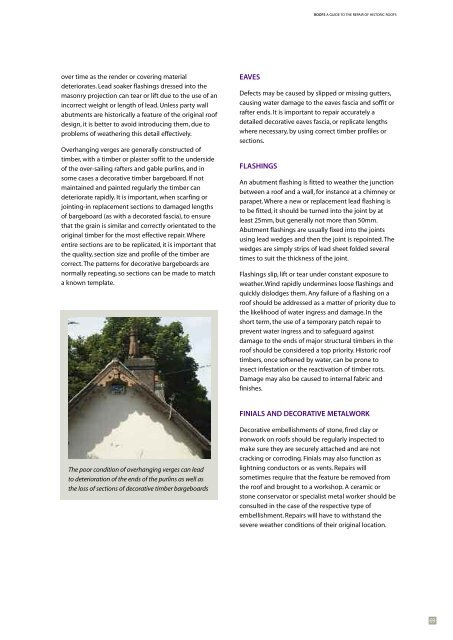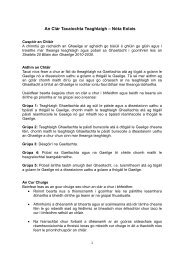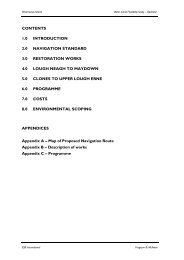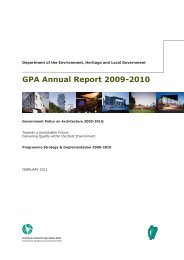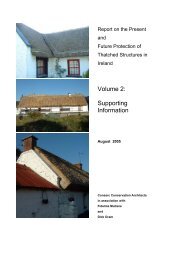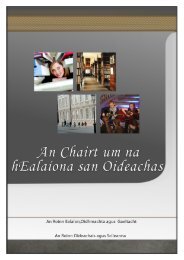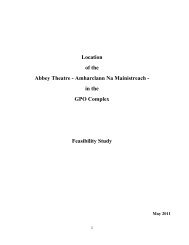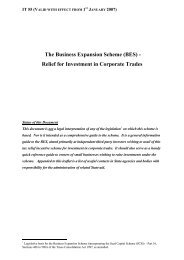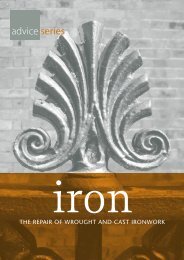A Guide to the Repair of Historic Roofs - Dublin City Council
A Guide to the Repair of Historic Roofs - Dublin City Council
A Guide to the Repair of Historic Roofs - Dublin City Council
Create successful ePaper yourself
Turn your PDF publications into a flip-book with our unique Google optimized e-Paper software.
ROOFS A GUIDE TO THE REPAIR OF HISTORIC ROOFSover time as <strong>the</strong> render or covering materialdeteriorates. Lead soaker flashings dressed in<strong>to</strong> <strong>the</strong>masonry projection can tear or lift due <strong>to</strong> <strong>the</strong> use <strong>of</strong> anincorrect weight or length <strong>of</strong> lead. Unless party wallabutments are his<strong>to</strong>rically a feature <strong>of</strong> <strong>the</strong> original ro<strong>of</strong>design, it is better <strong>to</strong> avoid introducing <strong>the</strong>m, due <strong>to</strong>problems <strong>of</strong> wea<strong>the</strong>ring this detail effectively.Overhanging verges are generally constructed <strong>of</strong>timber, with a timber or plaster s<strong>of</strong>fit <strong>to</strong> <strong>the</strong> underside<strong>of</strong> <strong>the</strong> over-sailing rafters and gable purlins, and insome cases a decorative timber bargeboard. If notmaintained and painted regularly <strong>the</strong> timber candeteriorate rapidly. It is important, when scarfing orjointing-in replacement sections <strong>to</strong> damaged lengths<strong>of</strong> bargeboard (as with a decorated fascia), <strong>to</strong> ensurethat <strong>the</strong> grain is similar and correctly orientated <strong>to</strong> <strong>the</strong>original timber for <strong>the</strong> most effective repair. Whereentire sections are <strong>to</strong> be replicated, it is important that<strong>the</strong> quality, section size and pr<strong>of</strong>ile <strong>of</strong> <strong>the</strong> timber arecorrect. The patterns for decorative bargeboards arenormally repeating, so sections can be made <strong>to</strong> matcha known template.EAVESDefects may be caused by slipped or missing gutters,causing water damage <strong>to</strong> <strong>the</strong> eaves fascia and s<strong>of</strong>fit orrafter ends. It is important <strong>to</strong> repair accurately adetailed decorative eaves fascia, or replicate lengthswhere necessary, by using correct timber pr<strong>of</strong>iles orsections.FLASHINGSAn abutment flashing is fitted <strong>to</strong> wea<strong>the</strong>r <strong>the</strong> junctionbetween a ro<strong>of</strong> and a wall, for instance at a chimney orparapet. Where a new or replacement lead flashing is<strong>to</strong> be fitted, it should be turned in<strong>to</strong> <strong>the</strong> joint by atleast 25mm, but generally not more than 50mm.Abutment flashings are usually fixed in<strong>to</strong> <strong>the</strong> jointsusing lead wedges and <strong>the</strong>n <strong>the</strong> joint is repointed. Thewedges are simply strips <strong>of</strong> lead sheet folded severaltimes <strong>to</strong> suit <strong>the</strong> thickness <strong>of</strong> <strong>the</strong> joint.Flashings slip, lift or tear under constant exposure <strong>to</strong>wea<strong>the</strong>r. Wind rapidly undermines loose flashings andquickly dislodges <strong>the</strong>m. Any failure <strong>of</strong> a flashing on aro<strong>of</strong> should be addressed as a matter <strong>of</strong> priority due <strong>to</strong><strong>the</strong> likelihood <strong>of</strong> water ingress and damage. In <strong>the</strong>short term, <strong>the</strong> use <strong>of</strong> a temporary patch repair <strong>to</strong>prevent water ingress and <strong>to</strong> safeguard againstdamage <strong>to</strong> <strong>the</strong> ends <strong>of</strong> major structural timbers in <strong>the</strong>ro<strong>of</strong> should be considered a <strong>to</strong>p priority. His<strong>to</strong>ric ro<strong>of</strong>timbers, once s<strong>of</strong>tened by water, can be prone <strong>to</strong>insect infestation or <strong>the</strong> reactivation <strong>of</strong> timber rots.Damage may also be caused <strong>to</strong> internal fabric andfinishes.FINIALS AND DECORATIVE METALWORKThe poor condition <strong>of</strong> overhanging verges can lead<strong>to</strong> deterioration <strong>of</strong> <strong>the</strong> ends <strong>of</strong> <strong>the</strong> purlins as well as<strong>the</strong> loss <strong>of</strong> sections <strong>of</strong> decorative timber bargeboardsDecorative embellishments <strong>of</strong> s<strong>to</strong>ne, fired clay orironwork on ro<strong>of</strong>s should be regularly inspected <strong>to</strong>make sure <strong>the</strong>y are securely attached and are notcracking or corroding. Finials may also function aslightning conduc<strong>to</strong>rs or as vents. <strong>Repair</strong>s willsometimes require that <strong>the</strong> feature be removed from<strong>the</strong> ro<strong>of</strong> and brought <strong>to</strong> a workshop. A ceramic ors<strong>to</strong>ne conserva<strong>to</strong>r or specialist metal worker should beconsulted in <strong>the</strong> case <strong>of</strong> <strong>the</strong> respective type <strong>of</strong>embellishment. <strong>Repair</strong>s will have <strong>to</strong> withstand <strong>the</strong>severe wea<strong>the</strong>r conditions <strong>of</strong> <strong>the</strong>ir original location.69


